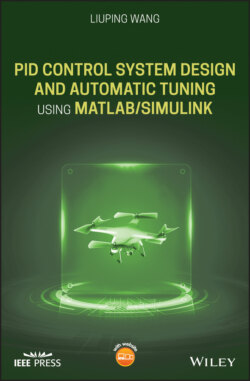Читать книгу PID Control System Design and Automatic Tuning using MATLAB/Simulink - Liuping Wang - Страница 29
1.3.2 Tuning Rules based on the First Order Plus Delay Model
ОглавлениеThe majority of tuning rules existing in the literature are based on a first order plus delay model, which has the following transfer function:
(1.44)
where is the steady-state gain of the system, is the time delay, and is the time constant. This is mainly because the primary applications of tuning rules are for process control where typically the process is stable with time delay. There are many methods available for obtaining a first order plus delay model. Among them is an incredibly simple procedure that is called fitting a reaction curve. This reaction curve is the so-called step response test.
The reaction curve is obtained by performing a plant step response test in open-loop operation, therefore we assume that the plant is stable, although it could be applied to integrating plant with caution. When performing this test, the plant input signal takes a step change from an initial constant value to a normal operation value, ; the measurement of the plant output signal in response to the step input change gives us the plant step response test data or the reaction curve. The response test completes when the value of the output signal reaches a constant or the signal fluctuates around a constant value due to noise and disturbances. Figure 1.14 illustrates a typical set of step response testing data, with the step change occurring at time . Figure 1.14(a) shows that the input takes a step change from the initial value to the final value and Figure 1.14(b) shows the actual output response from the steady-state output position to the steady-state output position .
The plant information obtained from the test includes the steady-state gain, defined as
(1.45)
Figure 1.14 Step response data. (a) Input signal. (b) Output signal. Key: line (1) the output response; line (2) steady-state output position before the response (); line (3) steady-state output position in completion of the response ().
The time delay is shown in the figure, which is the delayed time when the output responds to the change in the input signal. The parameter time delay reflects the situation that the output response remains unchanged despite the step input signal being injected. Thus, it is estimated using the time difference between when the step reference change occurred ( for this figure) and when the output response moved away from its steady-state value (see the time interval in Figure 1.14(b) marked with the first set of arrows). A line with maximum slope is drawn on Figure 1.14(b), which is intersected with the line corresponding to the indicator of . The intersecting point shown in Figure 1.14(b) determines the value of that is a measurement of the dynamic response time.
Alternatively, because the step response of a first order system () to a unit step input signal can be expressed as
and when the variable time ,
thus, we can determine the time constant using 63.2% of the rising time in the step response. This estimation of time constant gives a different value from the case when using the maximum slope approach. For the majority of the applications, this will result in a smaller time constant , and from the empirical tuning rules stated in the later part of the section, a smaller proportional gain will follow. One can evaluate this approach as an exercise using Problem 1.2.
Essentially, the step response test gives the parameters in the first order plus delay description of the process as in (1.44).
There is a second set of Ziegler–Nichols tuning rules that is based on the plant step response test data. This is also called the Ziegler–Nichols tuning rules using reaction curve. With these parameters, Ziegler–Nichols tuning rules using a reaction curve are given in Table 1.2. By the nature of this testing procedure (open-loop testing), the tuning rules should apply to stable systems.
Table 1.2 Ziegler-Nichols tuning rules with a reaction curve.
| P | ||||||
| PI | ||||||
| PID |
Table 1.3 Cohen–Coon tuning rules with a reaction curve.
| P | ||||||
| PI | ||||||
| PID |
There is another set of tuning rules that are derived based on the reaction curve, termed Cohen and Coon tuning rules. Table 1.3 gives the PID controller parameters calculated from Cohen and Coon tuning rules.
For the estimation of time delay , , and when using MATLAB, it is a fairly straight forward procedure to draw the lines and pinpoint the data points. The MATLAB command for finding the point on a graph is called ginput. For example, by typing
[a,b]=ginput(1)
a cross hair will appear on the MATLAB figure and a double click on the point of interest will yield the exact values we need. This graphic procedure will be demonstrated in the example section (see Section 1.5).
